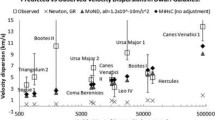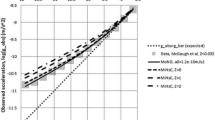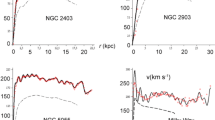Abstract
Galaxies and galaxy clusters have rotational velocities (v) apparently too fast to allow them to be gravitationally bound by their visible matter (M). This has been attributed to the presence of invisible (dark) matter, but so far this has not been directly detected. Here, it is shown that a new model that modifies inertial mass by assuming it is caused by Unruh radiation, which is subject to a Hubble-scale (Θ) Casimir effect predicts the rotational velocity to be: v 4=2GMc 2/Θ (the Tully-Fisher relation) where G is the gravitational constant, M is the baryonic mass and c is the speed of light. The model predicts the outer rotational velocity of dwarf and disk galaxies, and galaxy clusters, within error bars, without dark matter or adjustable parameters, and makes a prediction that local accelerations should remain above 2c 2/Θ at a galaxy’s edge.

Similar content being viewed by others
References
Aguirre, A., Schaye, J., Quataert, E.: Problems for MoND in clusters and the LYα forest? Astrophys. J. 561, 550 (2001)
Ahmed, Z., et al. (CDMS Collaboration): Phys. Rev. Lett. 102, 011301
Freedman, W.L.: Final results of the Hubble space telescope key project to measure the Hubble constant. Astrophys. J. 553, 47–72 (2001)
Haisch, B., Rueda, A., Puthoff, H.E.: Inertia as a zero-point-field Lorentz force. Phys. Rev. A 49, 678–694 (1994)
McCulloch, M.E.: Modelling the pioneer anomaly as modified inertia. Mon. Not. R. Astron. Soc. 376, 338–342 (2007)
McCulloch, M.E.: Modelling the flyby anomalies using a modification of inertia. Mon. Not. R. Astron. Soc. Lett. 389(1), L57–60 (2008)
McCulloch, M.E.: Minimum accelerations from quantised inertia. Europhys. Lett. 90, 29001 (2010)
McCulloch, M.E.: The Tajmar effect from quantised inertia. Europhys. Lett. 95, 39002 (2011)
McGaugh, S.S., Schombert, J.M., e Blok, W.J.G., Zagursky, M.J.: Astrophys. J. 708, L14 (2009)
Milgrom, M.: A modification of the Newtonian dynamics as a possible alternative to the hidden mass hypothesis. Astrophys. J. 270, 365 (1983)
Milgrom, M.: Ann. Phys. 229, 384 (1994)
Rubin, V., Thonnard, N., Ford, W.K. Jr: Rotational properties of 21 SC galaxies with a large ange of luminosities and radii from NGC 4605 (R=4 kpc) to UGC 2885 (R=122 kpc). Astrophys. J. 238, 471 (1980)
Sanders, R.H.: Clusters of galaxies with modified Newtonian dynamics (MoND). Mon. Not. R. Astron. Soc. 342(3), 901–908 (2002)
Tully, R.B., Fisher, J.R.: A new method of determining distances to galaxies. Astron. Astrophys. 54(3), 661–673 (1977)
XENON10 Collaboration: Phys. Rev. D 80, 115005
Zwicky, F.: Der Rotverschiebung von extragalaktischen Nebeln. Helv. Phys. Acta 6, 110 (1933)
Acknowledgements
Thanks to S. McGaugh, K. Rosser and an anonymous reviewer for advice, and B. Kim for encouragement.
Author information
Authors and Affiliations
Corresponding author
Rights and permissions
About this article
Cite this article
McCulloch, M.E. Testing quantised inertia on galactic scales. Astrophys Space Sci 342, 575–578 (2012). https://doi.org/10.1007/s10509-012-1197-0
Received:
Accepted:
Published:
Issue Date:
DOI: https://doi.org/10.1007/s10509-012-1197-0




